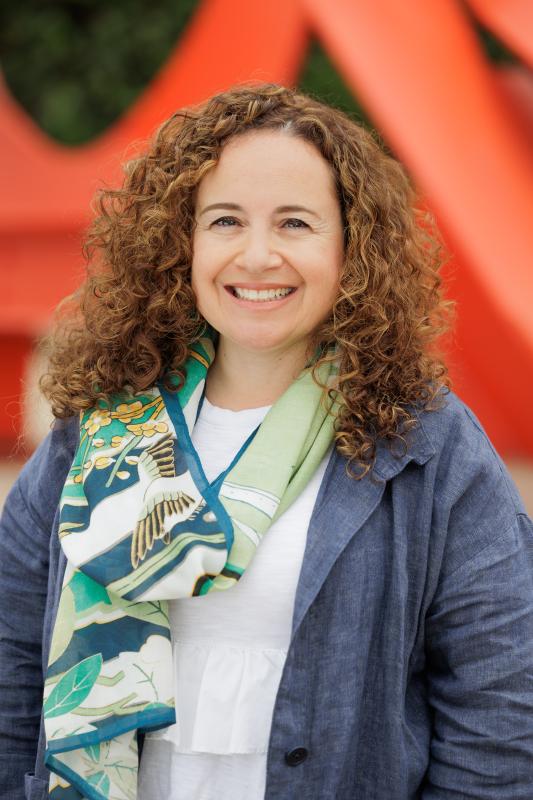The Artful Life Questionnaire: Amanda Cachia

Amanda Cachia. Photo courtesy of Dr. Cachia.
What we know for sure: We all have a story, and engaging with the arts helps all of us to tell our own stories on our own terms. We also know that there are ways to engage with the arts other than in formal cultural venues, and that sometimes it is more about the process of art making than it is about the end product. We also know that living an artful life, which is to say, living a life in which the arts and arts engagement are a priority means different things to different people based on their own interests, their communities, and many other factors, including equitable access. The Artful Life Questionnaire celebrates the diversity of ways we can make the arts a part of our lives, and, hopefully, inspires and encourages us to live our own unique versions of an artful life. In today’s edition of the questionnaire, we’re speaking with Dr. Amanda Cachia, a curator, critic, and art historian.
NEA: Please introduce yourself.
AMANDA CACHIA: Amanda Cachia, Ph.D., Assistant Professor of Arts Leadership in the Kathrine G. McGovern College of the Arts, University of Houston. I'm also an independent curator, critic, and art historian. Please check out my website for more information, www.amandacachia.com
NEA: Do you have a current art practice or a way of regularly engaging with the arts?
CACHIA: As an independent curator, I'm always working with museums and galleries and contemporary artists, which is a great way for me to keep abreast of the field. I'm fortunate that I've reached a stage in my career where many industry professionals are aware of the work I do and reach out to me to curate shows and organize projects for their institutions. I'm particularly sought after for curating exhibitions on contemporary disability art and curatorial activism.
NEA: What are five words that come to mind when you think about the idea of living an artful life?
CACHIA: Experimentation, joy, beauty, fulfillment, criticality.
NEA: Pick just one of those words and expand on how you see it as part of living an artful life.
CACHIA: Living an artful life means to live a life of experimentation, where every day might present a new challenge. I also consider an artful life as one where art itself is a consistent experimentation, striving for something new and different, to assist in achieving new goals and ambitions.
NEA: Where do you currently live, and what are some of the ways that your community tells its story through the arts or through creative expression?
CACHIA: I live between San Diego and Houston. Across both cities, artists are thinking critically about border and immigration issues, intersectional identity politics, issues of the environment, climate change, labor and domesticity, police violence, nationalism and war, and everything in-between.
NEA: How do you think that living an artful life can improve the well-being of your community?
CACHIA: Being open to experimentation means taking on a more flexible approach and an ever-widening world view which allows one to take on new views of others and the world around us. Having this open-minded attitude can certainly enhance the well-being of the community when we realize the diversity of personalities, socio-political cultures, and values we live in.
NEA: Is there a particular place in your neighborhood that is a creative touchstone for you?
CACHIA: I love the Museum of Contemporary Art in San Diego. I think the curators there are organizing fabulous and ground-breaking exhibitions, particularly since they opened last year after a period of renovation and expansion. I think the new Kinder building dedicated to modern and contemporary art at the Museum of Fine Art in Houston is truly breath-taking and it is so lovely to see so many iconic artists and artworks together in one space having a conversation.
NEA: What’s your favorite informal way or space to engage with arts and culture?
CACHIA: Books! I'm very at home with art books—reading them, and then writing about them.
NEA: If you hadn’t become an art historian, do you think the arts would still be a part of your life? In what ways?
CACHIA: Well, given I'm a curator and an art historian, art is already part of my life in various ways. Perhaps I would be an artist (which is a career I initially contemplated when I was initially drawn to art from a young age).
NEA: Can you share an arts experience or moment of arts engagement that has had an identifiable impact on your life?
CACHIA: When I was in my early twenties, I recall seeing many beautiful works by Australian Aboriginal artists at some larger-scale museums in Sydney, Melbourne, and Canberra in Australia. Each time I stood in front of these paintings, I could feel the energy and spirit of the artists and their indigenous ancestors, and truly was emotionally moved by the work. I knew then that art had this great power to convey who we are, and how valuable a tool it was to record ourselves and to teach others.






